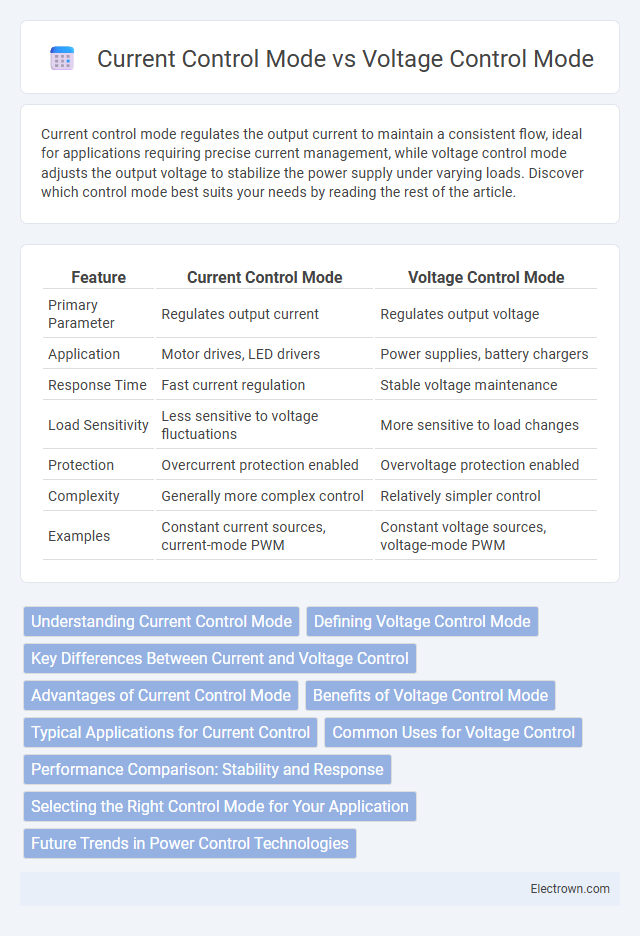Current control mode regulates the output current to maintain a consistent flow, ideal for applications requiring precise current management, while voltage control mode adjusts the output voltage to stabilize the power supply under varying loads. Discover which control mode best suits your needs by reading the rest of the article.
Table of Comparison
| Feature | Current Control Mode | Voltage Control Mode |
|---|---|---|
| Primary Parameter | Regulates output current | Regulates output voltage |
| Application | Motor drives, LED drivers | Power supplies, battery chargers |
| Response Time | Fast current regulation | Stable voltage maintenance |
| Load Sensitivity | Less sensitive to voltage fluctuations | More sensitive to load changes |
| Protection | Overcurrent protection enabled | Overvoltage protection enabled |
| Complexity | Generally more complex control | Relatively simpler control |
| Examples | Constant current sources, current-mode PWM | Constant voltage sources, voltage-mode PWM |
Understanding Current Control Mode
Current control mode regulates the output current by continuously adjusting the voltage to maintain a desired current level, providing precise control in applications such as motor drives and battery charging. This mode offers rapid response to load changes, reducing current ripple and enhancing system stability. Understanding current control mode is essential for optimizing power delivery and protecting components from overcurrent conditions.
Defining Voltage Control Mode
Voltage control mode regulates the output voltage of a power supply to maintain a constant voltage level regardless of load variations. It adjusts the current flow dynamically to stabilize the voltage at a predetermined setpoint, ensuring consistent power delivery. This mode is pivotal in applications requiring steady voltage, such as LED drivers and battery chargers.
Key Differences Between Current and Voltage Control
Current control mode regulates the current flowing through a device by directly adjusting the input to maintain a set current level, ensuring precise current management ideal for applications like LED drivers or motor torque control. Voltage control mode maintains a constant output voltage by varying the input signal, suitable for power supply circuits and devices requiring stable voltage levels. Key differences include the control target--current vs. voltage--and their application areas, where current control offers better protection against overcurrent conditions and voltage control ensures consistent voltage output under varying loads.
Advantages of Current Control Mode
Current control mode offers precise regulation of current flow, enhancing protection for sensitive components and reducing the risk of overheating. This mode provides faster dynamic response and better stability in applications requiring constant current, such as battery charging and motor drives. Your system benefits from improved efficiency and more accurate control when current is the primary parameter managed.
Benefits of Voltage Control Mode
Voltage control mode offers precise regulation of output voltage, ensuring stable performance in power electronic applications. This mode enhances system reliability by preventing voltage fluctuations that can damage sensitive components. Your devices benefit from improved efficiency and reduced electromagnetic interference when operating under voltage control mode.
Typical Applications for Current Control
Current control mode is typically used in applications requiring precise regulation of current to protect devices from overcurrent conditions, such as motor drives, battery charging systems, and power converters. This mode ensures stable torque in electric motors and accurate current delivery in welding machines, making it essential for processes where maintaining a specific current is critical. Your systems benefit from current control mode when consistent current flow directly impacts performance and safety.
Common Uses for Voltage Control
Voltage control mode is commonly used in applications where maintaining a stable voltage output is crucial, such as in power supplies, LED drivers, and battery charging systems. It ensures consistent voltage delivery to sensitive components regardless of load variations, enhancing device performance and safety. This mode is also preferred in renewable energy systems like solar inverters to regulate voltage and protect grid stability.
Performance Comparison: Stability and Response
Current control mode offers superior stability and faster transient response due to its direct regulation of the load current, minimizing overshoot and oscillations in dynamic conditions. Voltage control mode provides better output voltage accuracy under steady-state but may exhibit slower response and increased sensitivity to load disturbances, leading to potential instability in rapid load changes. The performance comparison highlights current control mode as optimal for applications requiring robust transient handling, while voltage control mode suits scenarios prioritizing precise voltage maintenance.
Selecting the Right Control Mode for Your Application
Current control mode is ideal for applications requiring precise regulation of current, such as battery charging and motor control, as it maintains a constant current regardless of voltage variations. Voltage control mode suits scenarios demanding stable output voltage, like power supplies and LED drivers, ensuring voltage remains consistent under varying loads. Selecting the right control mode depends on application-specific needs for either constant current or constant voltage to optimize performance and protect components.
Future Trends in Power Control Technologies
Future trends in power control technologies emphasize the integration of advanced algorithms and machine learning to enhance the efficiency of current control mode, enabling precise regulation in renewable energy systems and electric vehicles. Voltage control mode is evolving with smart grid implementations, utilizing real-time data analytics and adaptive voltage regulation for improved grid stability and resilience. Hybrid control systems combining current and voltage modes are emerging to optimize performance, reduce energy losses, and support the increasing demands of decentralized power generation.
Current control mode vs Voltage control mode Infographic

 electrown.com
electrown.com